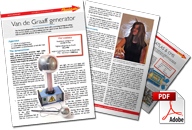Beach ball collider
How do the different types of particle collision differ? We learn the difference between particle–particle collisions of the sort used in the LHC and fixed-target collisions, by throwing more beach balls around…
Apparatus
n × beach balls
n/2 × electric pumps
The demonstrations
First, we try particle–particle, or centre-of-mass collisions:
- Place half the beach balls on one side of the audience and half on the other.
- Get the audience members to throw the balls at a point somewhere in the middle of the room, and see how many (or few!) collide.
Second, we try fixed-target collisions:
- Pick a fixed target. It’s most fun if this is a person, so a presenter, or a member of the audience if they’re up for it!
- Distribute the beach balls around the room and get audience members to throw them at the fixed target.
What it shows
Of the two kinds of particle collision, smashing particles into a fixed target is clearly simpler. In fact, if you think colliding beach balls thrown from opposite sides of the room is hard, try colliding two beams of protons, each the width of a human hair, moving at nearly the speed of light, which have travelled in opposite directions around the 27 km ring of the LHC! That’s exactly what happens at the collision points around the ring of the Large Hadron Collider.
The reason we bother with all this precision is because it gives us much more energy to play with in those collisions. Not only do you get the combined energy of both beams, but you get an additional bonus from conservation of momentum. The reason that particle–particle collisions are also known as centre-of-mass collisions is because the lab frame is also the centre-of-mass frame, and it’s possible for the products of a collision to be net stationary afterwards. (It’s actually a little less likely in the LHC because protons are composite particles and each quark carries a slightly different share of the momentum…but that’s another story.) In a fixed-target collision, the products need to be zooming off in the direction of the original beam’s momentum, rather like when you smash the cue-ball into the top of the triangle during a break in snooker, and that means that a lot of energy can’t be used to make new particles and find new physics, but is ‘wasted’ in the form of the products’ kinetic energy.
Alternatives
If you’re on tour and want a more compact solution, or simply want something which takes a bit less time to inflate, these particle collision demos work just as well with smaller balls.



